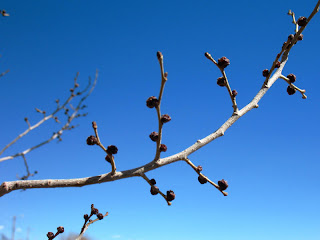 In the plant world, I saw a few early buds, like on this tree, which is possibly an elm (non-native).
In the plant world, I saw a few early buds, like on this tree, which is possibly an elm (non-native). Also, up in the hills, it's not so muddy and maybe the prickly pear is looking a little greener.
Also, up in the hills, it's not so muddy and maybe the prickly pear is looking a little greener.
Actually, until our most recent walk/hike, MOH and I together, I hadn't really noticed the prickly pear. They are small and low to the ground. One usually thinks of cactus as belonging in the true desert, not in pinon-juniper country, but I've found that some species of prickly pear can be found at relatively high elevation, growing in amongst the pinon-juniper (don't try to get me to narrow them down by species - my cactus book is at my other house, not out here in the field).
I've seen prickly pear at Pete's Summit in the Monitor Range of central Nevada (a place of pictographs and graptolites - take Highway 50 east from Austin to old 8A, turn south, and then immediately east toward Spencer's Hot Springs), and they grow here and there through the state. You won't, however, find any variety of cholla in with the pinon-juniper -at least not to my knowledge - cholla in Nevada grow to just a little bit north of Tonopah, which is a little farther north than the Joshua trees make it - the Joshua trees fade away somewhere between Goldfield and Tonopah, near the turnoff to Silver Peak.
Update: Other geoblogospheroids have been out walking: see Geology Happens and All of My Faults are Stress-Related.


2 comments:
Prickly pear grow in the pinyon-juniper ecosystem here, too. There's also at least one other barrelish cactus that I've sat on during a field lab. And yucca, which is really a lily, I guess, but I always classify it with cactus.
In the upper Arkansas River valley, just north of Salida, Colorado, I've seen cactus at 8000 or 9000 feet. The valley is high, but very dry, tucked between two north-south ranges with peaks up to 14,000 feet, and the ecosystems are a little different than here.
Yes, cactus are surprisingly hardy, and I think that despite what I said, that some member(s) of the cholla genus grow(s) way north of Tonopah - just not ones I've seen, or maybe not the obvious ones (I think maybe some cholla look more like other cactii types).
Post a Comment